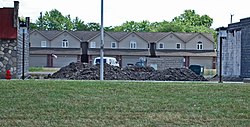Mellus Newspapers Building
 From Wikipedia - Reading time: 6 min
From Wikipedia - Reading time: 6 min
Mellus Newspapers Building | |
Formerly listed on the U.S. National Register of Historic Places | |
 Former site of building | |
 Interactive map | |
| Location | 1661 Fort St., Lincoln Park, Michigan |
|---|---|
| Coordinates | 42°15′6″N 83°10′31″W / 42.25167°N 83.17528°W |
| Area | less than one acre |
| Built | 1941 |
| Architectural style | Moderne |
| Demolished | 2010 |
| NRHP reference No. | 05000716[1] |
| Significant dates | |
| Added to NRHP | July 20, 2005 |
| Removed from NRHP | July 24, 2024 |
The Mellus Newspapers Building was a commercial building at 1661 Fort Street in Lincoln Park, Michigan. It was listed on the National Register of Historic Places in 2005,[1] and demolished in 2010.[2] The building was removed from the National Register of Historic Places in 2024.[3]
History
[edit]In 1933, William S. Mellus founded the Lincoln Parker, a newspaper serving the city of Lincoln Park.[2] As the population of Lincoln Park grew, Mellus eventually needed more space, and in 1941 he constructed this building on Fort Street.[2] Mellus also published newspapers for other downriver communities: The Allen Parker, Ecorse Advertiser, Southgate Sentinel, Taylor Tribune and Riverview Sentinel.[4] In the 1950s, a two-story addition was constructed in the rear of the building, enlarging the space to 4,080 square feet (379 m2).[5] Mellus also expanded operations into the next-door Pollack Jewellery Building.[5] Mellus sold his newspaper chain to Panax Corp. in the early 1970s. The company remained in the building until 1986, when it merged with Heritage Newspapers.[4] The building was sold by the Mellus family in 1994.[5]
In 2009, the Mellus and the next-door Pollack were purchased by the Lincoln Park Downtown Development Authority for $93,000.[6] The Mellus Building was demolished in May 2010; a small park is planned for the lot.[6]
Description
[edit]The Mellus Newspapers Building had simple but distinguishing Art Deco characteristics exemplifying the application of these to a small commercial building.[2] The front facade was covered with white porcelain enamel panels, and the entryway was framed with curved glass block sections. Six steel casement windows faced the front.[2]
References
[edit]- ^ a b "National Register Information System". National Register of Historic Places. National Park Service. March 13, 2009.
- ^ a b c d e Ren Farley. "Mellus Newspaper Building". Detroit1701.org. Retrieved July 20, 2010.
- ^ "Weekly List 2024 07 26". National Park Service. Retrieved August 1, 2024.
- ^ a b "Save the Mellus Newspapers Building". Lincoln Park Preservation Alliance. Retrieved July 20, 2010.[permanent dead link]
- ^ a b c "Historic gem or eyesore? Lincoln Park preservation group seeks developers for Mellus Newspaper building". Hometown History Tours. July 27, 2009. Retrieved July 20, 2010.
- ^ a b Nate Stemen (May 15, 2010). "LINCOLN PARK: Mellus Newspapers' building demolished; small park planned for site (with video)". The News-Herald.
 KSF
KSF


